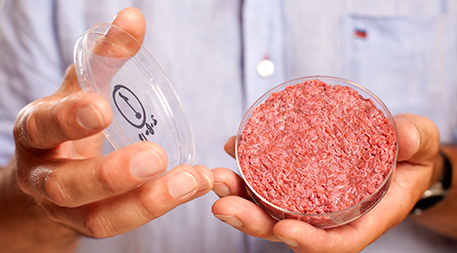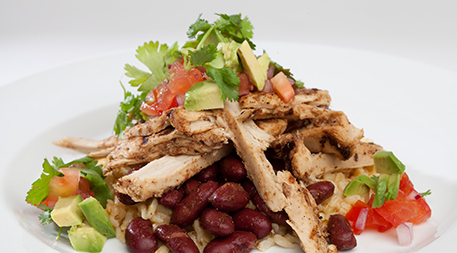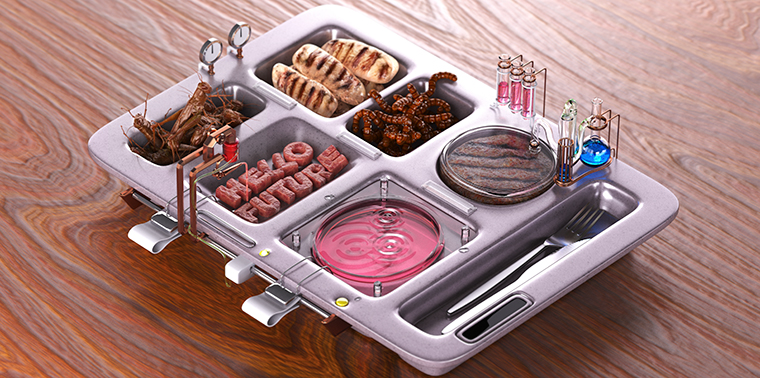July 28, 2014 —  The future of food arrived at Waitsfield Elementary School — a tiny brick throwback in Vermont’s pastoral Mad River Valley — just after lunch on May 15, 2014, in a handmade straw basket on the shoulder of Rachael Young. The cafeteria was still full of kids, so Young slipped into the kitchen as surreptitiously as possible. “Let’s see if we can do this on the sly,” she said to me. “I don’t want them to see anything ahead of time.”
The future of food arrived at Waitsfield Elementary School — a tiny brick throwback in Vermont’s pastoral Mad River Valley — just after lunch on May 15, 2014, in a handmade straw basket on the shoulder of Rachael Young. The cafeteria was still full of kids, so Young slipped into the kitchen as surreptitiously as possible. “Let’s see if we can do this on the sly,” she said to me. “I don’t want them to see anything ahead of time.”
We unpacked in a far corner of the kitchen, shooing away the occasional set of prying eyes. While I spread a ramp-knotweed pesto onto tortillas and cut them into eighths, Young found a pan, fired up the stove and dry-fried the main ingredient. “You may get a really weird smell in a moment,” she apologized. “It has something to do with the chitin when it’s heated. But it still tastes great!”
Young is the 34-year-old founder of Eat Yummy Bugs, a Vermont-based enterprise that encourages people to do just that, and a consultant with World Entomophagy, the premier supplier of “Recipe-Ready” crickets and mealworms for human consumption.
Like fedoras and Mickey Rourke, entomophagy (bug-eating) has experienced periodic but short-lived flares in popularity over the years. But this time it seems to have legs. You can snack on fried grasshoppers in New York and D.C., wrap your chopsticks around cricket sushi in Portland, Ore., and chow down on mealworm tacos from the Don Bugito food cart in San Francisco. Edible insect festivals are no longer news, and a variety of cricket-flour energy bars are dueling for retail shelf space.
What adds timeliness to the trend is the U.N. Food and Agriculture Organization’s recent report Edible Insects: Future Prospects for Food and Feed Security, which points out that 2 billion people already eat bugs and the rest of us had better get on it, because by 2050 the world population will have swelled from the current 7 billion to 9 billion or more. If the growth in demand for animal protein continues on its current trajectory, cows, pigs and chickens may need some help meeting it.
The Protein Problem
To feed those 9 billion or so people, a coterie of non-governmental organizations, government agencies and agriculture representatives tells us, we will need to double crop production by 2050. To do so, they say, we will need a massive initiative to improve yields through hi-tech farming, genetically modified crops and other such solutions.
But that’s not the whole story. In reality, we already produce enough potentially edible calories to feed 13 billion people three square meals a day. One-third of it, however, doesn’t get eaten by humans, but instead is fed to livestock, which turn it into protein we consume in the form of meat and dairy products. And that’s bad news for the environment for several reasons.
For one, the FAO named the livestock industry one of the biggest producers of greenhouse gases, topping even transportation. Worldwatch Institute scientists attribute about half of the problem to livestock. Beef cattle are notorious, generating 41 percent of the livestock industry’s GHG emissions, while pigs produce 9 percent and chickens, 8 percent. The reason? Cows are methane factories, and methane traps heat 40 times more effectively than CO2.
Meat production also requires massive amounts of water. It takes 500 gallons of water or more to produce a hamburger, mostly to grow alfalfa and other feed crops. Ironically, even as it is mired in the midst of one of its worst droughts ever recorded, according to James McWilliams, author of The Politics of Pasture, California is shipping 100 billion gallons of prime water per year to Asia in the form of alfalfa so Japan and China can feed their cattle. A third of the Colorado River, the faltering lifeline of Southwest U.S. cities, is used to grow forage crops.
Livestock are also tough on rainforests. Most Amazon land that has been cleared is now in ranching and feed crops. Worldwide, animal production is also a major cause of deforestation.
All of this would be bad enough if livestock were actually good producers of protein, but they aren’t. Livestock are quite inefficient at transforming vegetable calories into meat and dairy calories, so much of agriculture’s output is lost by turning plants into protein. It takes about 2.5 pounds of feed to make one pound of live chicken, 5 pounds of feed to make one pound of live pig and 10 pounds of feed for a pound of cow on the hoof. And even after all that converting, only 40–55 percent of the animal is edible. That’s a lot of grain, and it explains why 70 percent of our existing agricultural land is devoted to livestock.
It’s time to move beyond meat animals, suggest an increasing number of environmentalists, entrepreneurs and out-of-the-box thinkers.In other words, we don’t have a food problem. We have a protein problem. And it’s just going to get worse, pundits predict, because not only will 2.5 billion new people be added between now and 2050, but rising incomes and changing dietary preferences are expected to increase per-capita meat demand as well.
It’s time to move beyond meat animals, suggest an increasing number of environmentalists, entrepreneurs and out-of-the-box thinkers. Sure, this is an argument as old as vegetarianism itself, but this new generation of advocates isn’t suggesting we all endure a lifetime of Tofu Pups and bland black-bean soup. Instead, they are hacking meat itself. If most people crave meat (and a look at our species’ evolutionary history suggests we have every reason to) then let them eat it — in alternative forms that don’t stress the environment as much but are still delicious enough to make us all forget our mammoth-hunting glory years.
Gourmet vs. Gross
“So why not insects?” Young likes to ask. Insects don’t burn up lots of calories keeping themselves warm, and they thrive on food scraps. While it takes 27 pounds of feed to make 1 pound of hamburger, just 1.7 pounds of feed will get you a pound of ground cricket. Yet they are not without their issues, as Young admitted as we cooked. “I hate raising crickets. It sucks. They’re nocturnal, and they’re so noisy. If you have them in your closet, you just lie awake at night thinking, ‘Shut up!’”
As we talked, Young poured her pan of fried crickets into a metal bowl and handed them to me. “Try one,” she said. I popped a cricket into my mouth and chewed fast. It was crisp and crunchy, with a unique pistachio funk. Not bad at all. I could tell when I hit the head, which had a dense chewiness to it, like a dried blueberry. Pokey bits got stuck in the corners of my mouth, but no worse than your average tortilla chip.
Young tossed a second pan of sautéed mealworms with salt and cayenne. They were as crisp and insubstantial as a can of french-fried onions. While I placed three crickets on each tortilla wedge and sprinkled sprouts over the top, Young went into Eat Yummy Bugs mode for the 50 fifth and sixth graders gathered in the cafeteria. Firing up her PowerPoint presentation, she showed a photo of a cricket farm in Thailand. She told them how people all over the world have always eaten bugs. Then she rattled the students with a disturbing close-up of the head of a slaughtered pig. She talked about meat’s links to climate change and water pollution and world hunger. She played the shrimp card. “Who here likes shrimp?” Most hands went up. “What’s the difference between a shrimp and a cricket? Why is one gourmet and one gross? If you can eat a shrimp, you can eat a bug.”
A growing body of evidence suggests that pound for pound, producing insect protein is far friendlier when it comes to the environment than is producing protein from conventional livestock.
I asked the teacher standing next to me to predict the rejection rate. He surveyed the group, then said, “30/70. Thirty percent will be pushing forward, and the other 70 percent will be stampeding the other way.”
I hoped for better, because embracing creepy-crawlies could be an environmental boon. Raising a pound of mealworms produces a far lower carbon footprint than raising a pound of beef, and uses less land and water, too. It’s not a sustainability slam dunk — farming and processing insects has its own set of impacts, from producing large-scale amounts of feed to climate control and grinding, milling or preserving the final product — but a growing body of evidence suggests that pound for pound, producing insect protein is far friendlier when it comes to the environment than is producing protein from conventional livestock.
Vat Burger
Last year in London, Mark Post, a cell-culture expert at Maastricht University, cooked the world’s first “test-tube” burger and served it straight-up to two underwhelmed taste-testers in a live press conference. The burger — which took $325,000 of funding from Google’s Sergey Brin, who explained that he considers the current system of factory farming unworkable from both environmental and ethical standpoints — was made of 20,000 tiny strips of bovine muscle tissue, each grown in petri dishes and then combined with saffron, beet juice, bread crumbs and “a binder.” The saffron and beet juice were necessary to turn the bloodless burger a pleasing pink. The burger was fried in butter. The verdict was mixed.

Maastricht University professor Mark Post holds a burger made from cultured beef. Photo by David Parry / PA Wire.
“It’s close to meat,” said Hanni Rützler, a nutrition scientist, looking cornered. “It’s not that juicy. But the consistency is perfect.”
“It has a mouthfeel like meat,” agreed Josh Schonwald, author of The Taste of Tomorrow. “The absence is the fat.” Apparently all that butter wasn’t enough.
So what if it isn’t as dazzling as a T-bone? Many common foods taste downright strange if you stop and pay attention to them. I recently drove to my nearest McDonald’s, ordered a burger with nothing on it, removed it from its bun, and ate it like a cookie. Stripped of all the ketchup and pickles and cheese, it was weirdness itself. It had the texture of oatmeal. I have no doubts that in-vitro meat will soon pass the fast-food test.
But does it pass the environmentally benign test? Obviously, this early beta stage doesn’t even come close, but a much-cited 2011 article by Oxford researchers estimated that switching to cultured meat could reduce meat-production land use by 99 percent and greenhouse gas emissions and water use by up to 96 percent each. Yet barring a major technological breakthrough, cultured meats will never be commercially viable. The problem lies in the scalability and the raw materials. As synthetic biologist Christina Agapakis blogged at Discover, “Cell culture is one of the most expensive and resource-intensive techniques in modern biology. Keeping the cells warm, healthy, well-fed and free of contamination takes incredible labor and energy, even when scaled to the 10,000-liter vats that biotech companies use.” When you start to grasp the electricity, heat, antibiotics and sterilization involved, you start to appreciate the self-heating, self-healing cow. One U.K. study estimated that, even when done on a commercial scale, cultured meat would still be twice as expensive as conventional chicken meat.
It makes a great headline or TED talk (“Printed Meat!”), but Modern Meadow has barely begun to address such quibbles as flavor, color and cost, and is wisely banking more on printing leather than meat.
And the cells, of course, don’t grow out of thin air. They get their raw materials from the medium they grow in, a broth of sugars and amino acids that began as traditional feed crops before being “digested” in a factory somewhere — a process that is neither cheap nor efficient. In addition, they require fetal calf serum, which is collected from unborn cows in slaughterhouses. With no viable serum substitute on the horizon, and no legitimate claim to being any more “real” or tasty than the meat substitutes that have been around for years, it’s hard to see in-vitro meat’s path to viability.
That goes double for the other contender in the lab-meat field: 3-D printed meat. Modern Meadow makes the stuff by squirting a yellow slurry of vat-grown cow cells out of a nozzle into little strips. The cells self-adhere and, in theory, form a muscle-like texture. It makes a great headline or TED talk (“Printed Meat!”), but Modern Meadow has barely begun to address such quibbles as flavor, color and cost, and is wisely banking more on printing leather than meat.
Killer App
What’s the big deal about meat, anyway? These lab-meat ventures do us a favor by begging the question. The issue is not ontological status. I eat meat not because I have a desire to dance atop the food pyramid, but because I adore its savory succulence, something I can’t quite find in the tofus and tempehs of the world. The fact that the bloodless vat burger was made out of cells that share their DNA with a cow does nothing for me, and I suspect that most consumers who are willing to think outside the box on meat consumption are probably just as happy to step all the way out of the box — so long as they can take that meaty flavor and texture with them.

Southwest Style Chicken-Free Strips are one of several Beyond Meat products earning kudos from culinary critics. Photo courtesy of Beyond Meat.
Recently, I tore open my first package of Beyond Meat Chicken-Free Strips and sautéed the ivory-colored slabs with broccoli and onions. They made an undeniably delicious stir-fry — chewed like chicken and tasted, well, about as much like chicken as any of the actual pre-cooked chicken strips do. Beyond Meat is the brainchild of environmentalist and vegan Ethan Brown, who started his company to address livestock’s planetary impact, as well as animal-welfare issues. Its backers include Bill Gates and Twitter co-founders Biz Stone and Evan Williams. Its converts include food author and journalist Mark Bittman and chef Alton Brown. Its killer app is a trade secret that involves using steam, pressure and cold water to induce soy and pea proteins to hook up, Velcro-like, as do muscle proteins, and transform into white, fleshlike strips that chew and tear like chicken. That’s what sets it apart from the Boca Burgers of the world, which always tasted fine but chewed like the starchy lump of veggie mush that they were. Beyond Meat has now added a ground-beef impersonator. My teenage son pounded three “beef ” tacos in three minutes and headed out the door, none the wiser. A burger is due later this year.
Beyond Meat might have the numbers we need. According to the company, while it takes 192 square meters of land to produce one kilogram of protein from cattle and 64 square meters to produce a kilogram of protein from chickens, a kilogram of Beyond Meat protein has just 3.5 square meters of land backing it up. The dry feed demand differential is similarly striking: Beyond Meat uses just 4.8 kilograms of feed to produce a kilogram of protein, while chickens need 24.5 kilograms to do the job and beef, a hefty 69.4.
No plant-based meat substitute will ever perfectly replace a good steak or roast chicken, but it doesn’t have to. The low-hanging fruit is the burritos and burgers of the world.At $5.29 for 12 ounces, Beyond Meat is not going to cure China — or even Chipotle — of its flesh addiction quite yet, but Brown assured me that one more round of scaling up and “our ability to dramatically underprice meat becomes clear.” He has his sights set on China, where he pointed out that a switch to a full Western diet would consume nearly the world’s entire supply of chicken.
No plant-based meat substitute will ever perfectly replace a good steak or roast chicken, but it doesn’t have to. The low-hanging fruit is the burritos and burgers of the world, the daily disposable meals quickly eaten and just as quickly forgotten. I can easily see a near future where people reserve their consumption of “real meat” for special occasions. But I wouldn’t be surprised if the trend went even further. Perhaps the people of 2050 will shake their heads in incomprehension at our feedlot economy the way we do at our ancestors’ plantation economy, and will no longer expect sentient animals to do the work of converting grain into juicy bundles of protein.
Why Not?
Paradigm shifts rarely happen as we think they do, with the needle slowly moving from Normal to New Normal. Instead, they tend to follow the gay marriage model, burbling in the collective unconscious for years as an outlandish idea until one day everybody shrugs their shoulders and says, “Why not?” “First they ignore you, then they laugh at you, then they fight you, then you win,” said Gandhi. Most meat-alternative proponents are still at Gandhi’s stages 1 and 2.
The moment my skepticism about novel proteins turned to outright boosterism came a few seconds after Rachael Young finished her presentation to the Waitsfield Elementary School kids. I was standing on the side, holding the bowl of spicy mealworms, having distributed the salted crickets and cricket tortillas to the other teachers.
Mealworms, I thought, are the gateway bug.“Okay,” Young said, “who’s ready to eat yummy bugs?” A feral squeal went up from the kids and they charged, hitting us like a wave. Small fists dug into my mealworms and I found myself fighting to get my share. Suddenly it felt like the most natural thing in the world to be popping handfuls of these crackly, toasty, mushroom-scented sticks into our mouths. Mealworms, I thought, are the gateway bug.
Afterward, Young had the kids write flavor descriptors on a blackboard. Under the crickets, they wrote “potato chips,” “burnt popcorn,” “thick!” and “hard to swallow (legs).” Under the mealworms: “Stale corn chip,” “flacky,” “smooshy” and “weird/good.” In the debriefing afterward, one girl said matter-of-factly, “I think it would have been more appealing for me if the crickets didn’t have eyes.” But another said, “After you ate one, you kinda wanted to eat more.”
The proportion of students rejecting the idea of eating insects turned out to be 6/94. If that ratio, or anything even close, holds for the rest of humanity, the future of protein is about to get very, very interesting.
And why not? At some level, it’s all weird/good. First they gag. Then they giggle. Then you win. ![]()
UPDATED 07.30.14: The article was updated to identify Rachael Young as a consultant with World Entomophagy.
Ensia shares solutions-focused stories free of charge through our online magazine and partner media. That means audiences around the world have ready access to stories that can — and do — help them shape a better future. If you value our work, please show your support today.
Yes, I'll support Ensia!
